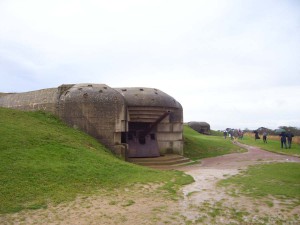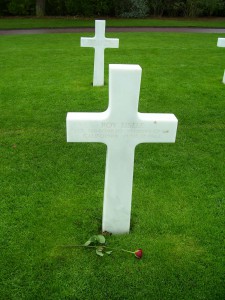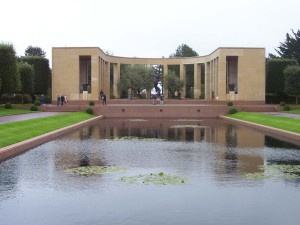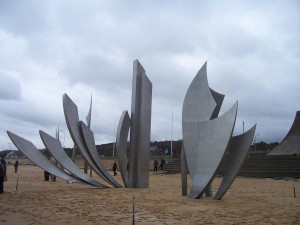FROM PARIS TO NORMANDY ON THE SEINE – THE NORMANDY BEACHES
FROM PARIS TO NORMANDY ON THE SEINE
This is the ninth in a series of articles about cruising on the Seine
THE NORMANDY BEACHES
By Charles N. Stevens
Photos by Dolores Seidman
This morning we are docked at Honfleur, having arrived during the night. We’re up early, earlier than the sun. I can’t see anything outside except darkness and the quivering reflections of dock lights on the water.
The first rays of the sun reveal glistening wet streets and a dull overcast. Today will be the highlight of our trip, a visit to the Normandy Beaches where the Allied invasions took place on D-day, June 6, 1944. I had been in England on D-day and felt the electricity in the air, the supercharged emotion of that day. I remember attack bombers banking in formation over our barracks, on their way to the French coast to aid the invading troops. I began flying bombing missions myself a week later, some of the raids organized to help the troops on the ground.
Buses pick us up at the docks in Honfleur, the main part of the town being about a half mile away. The first leg of our tour is to the large city of Caen. The soggy countryside is subdued by gray clouds and mist, the weather similar to what the troops faced on D-day. We pass vast fields and pastures where dairy cows graze and farm houses and barns with high-pitched roofs dot the landscape. Sheep graze in gently rolling hills, the deep green of the grass showing through despite the clouds and soft rain.
Soon we begin to see the many church spires of Caen, a city of 190,000 people. It had been established by William the Conqueror in 1204. It is here that we pick up our guide, a man who actually had to live in a trench as a little boy during the war.
On the way we pass more fields, some of them recently plowed, a few still thick with dried feed corn stalks. Corn is not raised for human consumption here, only for cattle and the dairy industry. The area is famous for Camembert cheese, yogurt, milk, and cream.
We skirt the large city of Bayeux where a bronze statue of Eisenhower with his hands on his hips greets motorists near a roundabout. Nearby is a British Cemetery where five thousand soldiers lie buried, casualties of the invasion. Red roses grow among the crosses.
Out in the open country again, we pass many apple orchards, the fruit for making cider. We also see the unusual Norman cows, white with some black splotching and always with black around the eyes as though they are wearing sun glasses.
Through these peaceful scenes we reach the equally peaceful bluffs overlooking the English Channel and the sandy beaches below. Staggering along muddy paths and slippery wet grass with our umbrellas up we come to what is left of the German bunkers once used to protect the French coast. A cannon barrel still protrudes from one of them, the thick, rounded concrete around it stained with years of rain and wind and scabbed with lichens. We carefully walk inside the bunker, behind the cruel, rusty mechanism of the cannon, and the concrete rooms where the Nazis stored shells and powder. It is eerie to think that these giant guns were once trained on our invasion ships. The only bright spot is that the crews that manned these guns came out with their hands up after only one day. One problem that Germans had was that the barrel would heat up so much from firing that they had to allow it to cool, thus wasting time. Also they could not practice because there was nothing to shoot at. They tried towing out practice targets from Cherbourg, but the British Air Force would always destroy them. The living quarters for the gun crews were underground in a field behind the guns. We can still see the concrete opening to these quarters.
Our bus backtracks to the village of Arromanches, now a tourist town because of its position in the midst of the Allied invasion. One of its highlights is a World War II Museum, one that offers free entry for veterans and their wives. Dolores and I spend an hour looking at their artifacts, photographs, spectacular models and movies, much of it explaining how the invasion took place. The rain has stopped for a while, and we are able to munch our box lunch on a concrete bench overlooking the beach. Where we are now was once named Gold Beach by the British and is a place where a harbor was constructed by sinking concrete caissons in a wide semi circle with an opening for ships. Many of these are still where they were placed then, now looking dark against the silver of the sea. They now form a kind of memorial for the invasion, and as a practical matter, provide homes for fish.
The weather changes and the sea becomes gray-blue, the sky gray and streaky with the threat of showers. Lazy waves ripple on to the sandy beach. A boy fashions a sand castle with his dad. I can’t help but think how wonderful this is, how symbolic of peace this is, compared to the mayhem that occurred here during the war.
By a series of small roads we reach the American Cemetery, rows on rows of crosses and Stars of David surrounded by a park-like setting of grass, trees and shrubs—almost like a national park. The American flag snaps in the wind as we gather in a columned memorial. A short ceremony includes “The Star Spangled Banner” and “taps” played on a trumpet, all of which were touching. The veterans of World War II are asked to line up in the center. There are four of us only. It seems that hundreds of cameras point at us, flashes coming in rapid succession. I almost feel important.
Each of us is given a rose to place on the grave of our choice. Not knowing anyone buried there I look for an airman like myself, preferably one from California. We find the cross of 1st Lt. Roy Eisele of the 303rd Bomb Group, his field located only a few miles from the one where I was based in England. He was also from California. He was killed only six days after D-day and two days before I flew my first mission. In a light drizzle we place the rose at the base of the cross. I feel my throat tighten and a tear threatens to well up in my right eye. Ten thousand headstones are in the cemetery. 20,000 Americans and 60,000 Germans were killed.
We move on to Omaha Beach where the Americans stormed the shore. We walk on the damp sand of the beach that would have been a scene of chaos in 1944. Today the beach is benign, gentle waves washing up on the tan-colored sand. Seagulls gather on the strand. It is a privilege to stroll on this firm beach where so much history was made. Protruding right out of it is a wonderful memorial sculpture, wing-shaped stainless steel curving up in three sections—The Wings of Hope, The Rise of Freedom and The Wings of Fraternity.
The landing occurred at 6:30 in the morning at low tide. German machine guns in small concrete bunkers were waiting for them. Many bunkers are still visible in the low hills overlooking the beach and at the sides of roads leading up from the beach, places to mow Americans down. Other larger bunkers nestle back of the beach at the base of low hills. Some Frenchmen have deliberately built their homes on top of them, using the cave-like bunkers for wine cellars.
After the troops passed the beach and marched inland they had to contend with hedgerows, the thick tangle of shrubs and earth that farmers used to separate their fields. These were perfect for the Germans who hid behind them and waited for the Americans to come. The Americans called it “Hedgerow Hell.”
Our next venue is Pointe du Hoc where American Rangers had to scale cliffs that nearly reached the water, an arduous, very dangerous task, one that we can hardly imagine. At the top of the cliffs were more German bunkers. We negotiate a treacherous path of more mud and wet grass that leads to them and the grassed-over bomb craters made by American A-20 attack bombers on D-day. The wind is fierce here, rattling the trees and chilling us to the bone. We slip and slide on the pathway, our concern with falling cutting down on our enjoyment.
It had been a long, tiring day, but we rest now on our comfortable bus, warm and dry, on the way back to Caen and Honfleur. Most of all we have a greater appreciation for what those troops endured to finally begin to rout the Germans from France and push them all the way back to Berlin.

This German bunker housed a cannon used to fire on our invading troops during the Normandy landings

The cross in the American Cemetery bears the name of 1st Lt. Roy Eisele, a Californina airman like myself.

An overview of the American Cemetery in Normandy.

The sculpture at Omaha Beach representing "The Wings of Hope", "The Rise of Freedom" and "The Wings of Fraternity."



